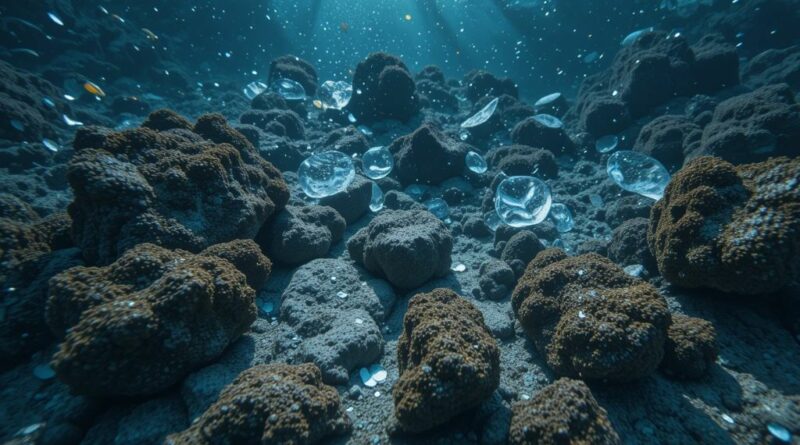Dark Oxygen: The Revolutionary Ocean Science Discovery
In the pitch-black depths of the Pacific Ocean, more than 12,000 feet below the surface where sunlight has never penetrated, an extraordinary phenomenon is quietly revolutionising our understanding of life on Earth—and possibly beyond. Scientists have uncovered compelling evidence that mysterious metallic rocks scattered across the deep ocean floor are producing oxygen without any help from photosynthesis, challenging one of biology’s most fundamental assumptions.
This groundbreaking discovery, published in Nature Geoscience by an international team led by marine biologist Andrew Sweetman, reveals that polymetallic nodules—potato-sized lumps of metal that have formed over millions of years—act as natural batteries, splitting seawater into hydrogen and oxygen through a process now termed “dark oxygen” production.
The Accidental Revolution
The discovery emerged from what was initially intended to be routine research in the Clarion-Clipperton Zone, a vast expanse of the Pacific Ocean between Hawaii and Mexico. “This is a totally new and unexpected finding,” notes Lisa Levin, an emeritus professor of biological oceanography at the Scripps Institution of Oceanography, capturing the scientific community’s astonishment at these results.
For decades, scientists operated under the iron-clad assumption that oxygen production on Earth was exclusively the domain of photosynthetic organisms—plants, algae, and cyanobacteria that harness sunlight to convert carbon dioxide and water into oxygen. This new research has shattered that paradigm, revealing that seawater electrolysis can occur naturally in the abyss, powered by the electrical properties of metallic minerals.
Nature’s Deep-Sea Batteries
The polymetallic nodules responsible for this phenomenon are geological marvels in their own right. “The polymetallic nodules that produce this oxygen contain metals such as cobalt, nickel, copper, lithium and manganese — which are all critical elements used in batteries,” explained Franz Geiger, the Northwestern University chemist who co-authored the study. These mineral deposits grow incredibly slowly, accumulating layers of metal over millions of years as dissolved minerals precipitate from seawater.
Laboratory testing revealed that individual nodules could generate up to 0.95 volts. A charge of 1.5 volts would induce electrolysis to separate water molecules into oxygen and hydrogen. When multiple nodules cluster together on the seafloor—as they naturally do—their combined electrical output can exceed the threshold needed to split water molecules, creating pockets of oxygen in one of Earth’s most oxygen-starved environments.
Rewriting Deep-Sea Ecology
The implications for marine biology are staggering. Experiments at the polymetallic nodule-covered abyssal seafloor in the Pacific Ocean showed oxygen increased over two days to more than three times the background concentration. This suggests that deep-sea ecosystems, long thought to depend entirely on the slow trickle of oxygen from surface waters or chemosynthetic processes around hydrothermal vents, may have access to a previously unknown local oxygen source.
This revelation could explain the surprising biodiversity found in some deep-ocean regions. Tiny sea creatures and microbes that make their homes on and around these nodules may be benefiting from localised oxygen production, creating unexpected oases of life in the deep. The discovery challenges our understanding of how aerobic life could have evolved and survived in Earth’s most remote environments.
Astrobiology’s New Frontier
Perhaps the most tantalising implications of dark oxygen production extend far beyond Earth’s oceans. If metallic minerals can generate oxygen in the absence of sunlight, similar processes could potentially occur on other worlds, opening unprecedented possibilities for extraterrestrial life.
Research findings indicate that complex life fuelled by dark oxygen is plausibly capable of inhabiting submarine environments devoid of photosynthesis on Earth, conceivably extending likewise to extraterrestrial locations such as icy worlds with subsurface oceans (e.g., Enceladus and Europa). This connection to astrobiology represents a paradigm shift in how scientists approach the search for life beyond Earth.
Jupiter’s moon Europa and Saturn’s moon Enceladus both harbour vast subsurface oceans beneath their icy crusts. These alien seas, heated by tidal forces and potentially rich in dissolved minerals, could theoretically support similar electrolytic processes. If metallic minerals in these distant oceans can generate oxygen, they might sustain complex ecosystems entirely independent of their host stars’ light.
Mining Controversy and Conservation Concerns
The discovery has intensified debates surrounding deep-sea mining, an emerging industry targeting polymetallic nodules for their valuable metals. The finding could strengthen the case against controversial deep-sea mining, as these operations would essentially harvest the very source of dark oxygen production.
As lead researcher Sweetman noted: “Through this discovery, we have generated many unanswered questions and I think we have a lot to think about in terms of how we mine these modules, which are effectively batteries. The intersection of technological demand for battery metals and ecological preservation presents a complex challenge for policymakers and environmental advocates.
Scientists emphasise that “the production of oxygen at the seafloor by polymetallic nodules is a new ecosystem function that needs to be considered when assessing the impact of deep-sea mining.” This adds another layer of complexity to environmental impact assessments for proposed mining operations in international waters.
Scientific Scrutiny and Future Research
As with any revolutionary scientific claim, the dark oxygen discovery has faced scrutiny from the research community. Some critics have questioned the experimental methodology, citing concerns about “poor-quality lander incubation experiments, leading to faulty oxygen flux measurements.” This healthy scientific scepticism is driving additional research to validate and expand upon the initial findings.
The controversy underscores the importance of rigorous peer review and replication in scientific discovery, particularly when findings challenge established paradigms. Independent verification studies are already underway at multiple research institutions, and the scientific community awaits additional data to confirm the extent and significance of dark oxygen production.
Implications for Earth’s History
The discovery of dark oxygen production also raises intriguing questions about Earth’s evolutionary history. Could similar processes have contributed to the Great Oxidation Event that transformed our planet’s atmosphere billions of years ago? While photosynthetic cyanobacteria are widely credited with introducing oxygen to Earth’s atmosphere, dark oxygen production may have played a supporting role in creating localised oxygen-rich environments that facilitated the evolution of aerobic life.
This possibility suggests that our understanding of Earth’s oxygenation may be incomplete, with electrochemical processes in ancient oceans potentially contributing to the conditions that allowed complex life to flourish.
The Technology Connection
The natural battery-like properties of polymetallic nodules also offer insights for materials science and energy storage technology. Understanding how these natural systems generate electrical current could inspire new approaches to sustainable energy storage and underwater power generation. The metals found in these nodules—cobalt, nickel, copper, lithium, and manganese—are precisely the elements crucial to modern battery technology.
Future Expeditions and Research Priorities
The dark oxygen discovery has catalysed a new wave of deep-ocean research expeditions. Scientists acknowledge that “it’s unclear what causes dark oxygen, but a possible source could be polymetallic nodules,” indicating that much work remains to fully understand the mechanisms involved.
Priority research areas include:
- Mapping the global distribution of dark oxygen production
- Understanding the biological communities that depend on this oxygen source
- Investigating similar processes in other deep-ocean environments
- Assessing the long-term stability of these electrochemical systems
- Exploring potential applications for human technology
Conclusion: A New Chapter in Ocean Science
The discovery of dark oxygen production represents more than just another scientific finding—it’s a fundamental shift in how we understand life’s possibilities in extreme environments. From the deepest trenches of Earth’s oceans to the hidden seas of distant moons, this research opens new avenues for exploration and discovery.
As researchers emphasise, these findings “not only reveal unexpected truths, but also highlight the importance of acting according to the Precautionary Principle” when it comes to deep-sea environments. The revelation that million-year-old rocks on the seafloor can generate the oxygen that sustains life challenges us to reconsider our assumptions about the conditions necessary for complex ecosystems.
As we stand on the brink of a new era in both deep-sea exploration and the search for extraterrestrial life, the humble polymetallic nodules scattered across Earth’s ocean floor remind us that the universe still holds profound secrets waiting to be discovered. In the darkness of the deep, where no sunlight has ever shone, life may be finding ways to create its own light—or in this case, its own breath.
The story of dark oxygen is still being written, with each new expedition and laboratory experiment adding chapters to our understanding of life’s remarkable adaptability and the hidden processes that sustain it in Earth’s most extreme environments.
We’d love your questions or comments on today’s topic!
For more articles like this one, click here.
Thought for the day:
“If we weren’t born with anti-social passions – narcissism, envy, lust, meanness, greed, hunger for power, just to name the more obvious – why the need for so many laws, whether religious or secular, that govern behaviour?” Dennis Prager



